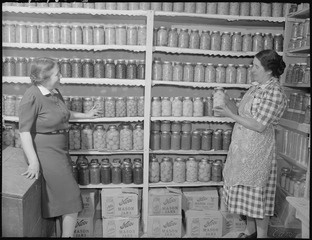 Food storage is an essential part of any crisis plan, but where do you store all of those supplies? What if you live in an apartment that’s somewhat challenged in the square footage department? Where are you going to store all of that food?
Food storage is an essential part of any crisis plan, but where do you store all of those supplies? What if you live in an apartment that’s somewhat challenged in the square footage department? Where are you going to store all of that food?
Unless you invest in compact food buckets with a shelf life of 25+ years, there are a surprising number of considerations that go into the process. Each storage location has a unique set of pros and cons. Basements, closets, furniture, attics, storage sheds… all of these can vary widely in temperature, humidity, etc.
Here’s a list of 15 common places to store survival food, along with recommendations for each one.
- Kitchen shelves: For homemade preserves and canned foods with shelf lives less than 1 year, it’s best to keep them accessible.
- Kitchen pantry: If your food storage includes items that must be rotated periodically (before they expire), it’s best keep them where you’ll be able to use them.
- Duct taped to furniture:
 If secrecy is a top concern, then you may want to get creative with some duct tape (see photo). By taping cans, boxes, and bags to the back of shelving, you can hide quite a bit of food in the open spaces of your home. I don’t recommend duct taping it to the wall… that can get messy.
If secrecy is a top concern, then you may want to get creative with some duct tape (see photo). By taping cans, boxes, and bags to the back of shelving, you can hide quite a bit of food in the open spaces of your home. I don’t recommend duct taping it to the wall… that can get messy. - Broom closet: Since it’s climate controlled, you can use your broom closet as a survival pantry. With some wall-mounted shelving you may be able to fit your food and some cleaning supplies.
- Blanket storage trunk or ottoman: If you have a piece of furniture that has a built-in area for linen storage, that’s a great place to store dried beans, in a mylar bag of course.
- Decorative boxes: A lot of people place decorative hat boxes on top of armoires and furniture. This is a great place to store bags of beans, baking supplies, and any other long-term dry storage.
- Utility room/mudroom: Since mudrooms are usually filled with clutter anyway, it’s a good place to stash some large water jugs.
- Basement: If your home has a basement, then you’ve got an excellent storage area for water, canned goods, along with tons of other necessities like soap, shampoo, and disinfectants. Basements can be damp, so avoid items that would be negatively affected by moisture.
- Garage: Garages can have widely fluctuating temperatures depending on your climate and how well-insulated they are, so choose what goes into your garage accordingly. Any edible items stored in your garage should be placed in mylar bags and stored in 5-gallon buckets.
- Attic: Attics can be okay for paper goods like toilet paper, paper towels, paper plates, trash bags, and other non-food items. Heat in attics is too extreme for food. Store these in Rubbermaid-style containers to prevent rodents from nesting in paper goods.
- Laundry room closet: Laundry room closets are great places to store buckets of bulk grains, pastas, etc.
- Front hall closet: I’ve seen some enterprising survivalists fit their entire food supply, inside of rolling Rubbermaid carts, inside their front hall closets.
- Bedroom closets: Most bedroom closets are maxed-out as it is. But you can probably find room for a first aid kit and medical supplies, possible a few boxes of cereal and canned food as well.
- Under beds: You can fit a surprising amount of food in rolling under-the-bed containers. Throw in a few bottles of water and you’ve got a nice cache.
- Outbuildings: Barns, sheds, and detached garages can all provide abundant space. However the same rules that apply for garages apply for other outbuildings. Beware of extremes in temperature, moisture, and rodents and other pests.

